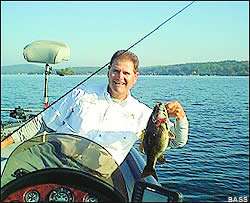
GILFORD, N.H. — Although it's in New Hampshire, Lake Winnipesaukee can be considered the home waters of many anglers throughout New England. Several competitors should be familiar with Lake Winnipesaukee when it hosts the CITGO BASS Federation Eastern Divisional Sept. 22-24. "Other than Lake Champlain, it is the biggest and the most popular tournament site in New England," said Steve Lucarelli, a member of the Winni'g Anglers BASS Federation Club and a veteran Lake Winnipesaukee guide. "Guys from a number of states (Rhode Island, Connecticut and Massachusetts), call it their home lake, and they all know the lake as well as the guys in New Hampshire."
Like most bass fisheries in the New England region, Winnipesaukee is a rocky glacial lake. However, its size makes the lake unique. The clear-water lake covers about 44,000 acres and has a shoreline length of 182 miles. Bass-holding structure at Winnipesaukee includes sand, gravel and rock points, shoals and about 251 islands. "There are a lot of docks and some 'smallie' weeds, which is a form of broadleaf cabbage," said Lucarelli of the primary cover in his home lake.
Winnipesaukee contains flourishing populations of both smallmouth and largemouth bass. "You can catch smallmouth between 2 to 2 1/2 pounds all day long," says Lucarelli. Largemouth average about 1 1/2 to 2 1/2 pounds, while 5- to 6-pounders are considered lunkers.The water temperature should be in the upper 60s to low 70s during the tournament, so a variety of patterns should produce then. Lucarelli predicts largemouth will be taken on buzzbaits, and smallmouth will hit Zara Spooks or Storm Lures Rattlin' Chug Bugs in the mornings.
Another productive technique will be throwing wacky rigged Senkos (green pumpkin, watermelon or cinnamon) on weighted hooks around docks and weeds to catch suspended smallmouth. Other lures Federation competitors can depend on during the tournament include green pumpkin or watermelon tube baits and Carolina rigged Senkos, finesse worms or plastic lizards in green pumpkin or watermelon hues. The whole lake should produce good fishing during the tournament. "If there is a good trick I can give to anyone who has never been on this lake, it is to take a section of it and learn that area, because the smallmouth are everywhere," suggested Lucarelli. "Don't try to learn a spot and go 27 miles away to another spot." Lucarelli believes it will take a mixed bag of largemouth and smallmouth to win the Divisional. "Someone has to have a 2 1/2-pound average to be in the ballpark," he estimated. "A guy will have to do 40 to 42 pounds to really make some noise." He predicts the overall winner will bring in 42 to 45 pounds."I wish I could say we are homers in New Hampshire and that we really have an advantage over the neighboring states in this tournament, but that's not the case," said Lucarelli, who will be competing on New Hampshire's state team, along with his son, Joe. "The guys from Rhode Island, Connecticut, Maine and Massachusetts are equally as knowledgeable about the lake as the New Hampshire fishermen." A lot of home-waters pride is on the line for this event, so Lucarelli has issued a challenge to one of the rival states. "Massachusetts has beaten us here before, so I'm drawing the line in the sand," declared the local guide. "Tell Massachusetts to bring it."

